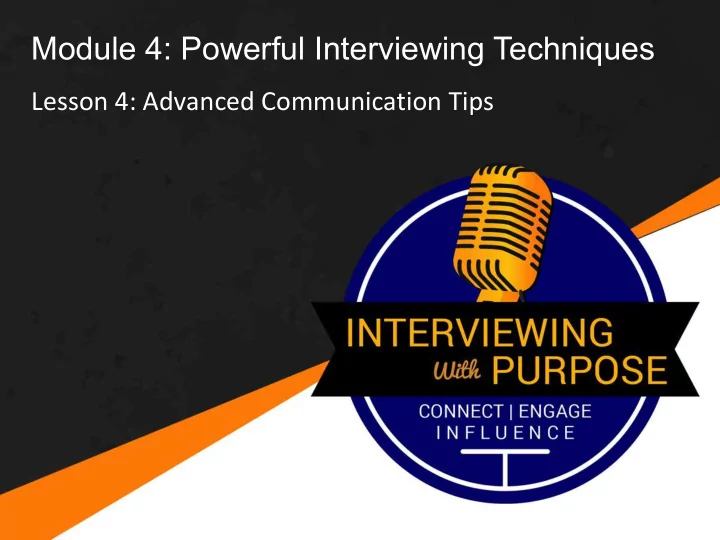

Module 4: Powerful Interviewing Techniques Lesson 4: Advanced Communication Tips
In this training you will learn: • Why is this important • Techniques and How you can leverage them: • Tonality (Tone); • Avoid sounding Monotone; • Rhythm and Tempo; • Embrace the ‘pause’ [silence] 2
Why is this important? • HOW you show up creates an experience; what experience do you want to create? • You can change the atmosphere of the interview just by changing your voice; tone; pitch; speed; 3
Technique: Tonality (Tone) • The quality of a person’s voice; their manner of speaking; how they express themselves; • Example: When speaking with young children (in comparison to adults) our voice will be much softer, a little higher; • She spoke in a ‘conversational tone’; • He spoke in a ‘nervous tone’’. 4
Technique: Tonality (Tone) • She had a ‘confident tone’ in her voice; • A quiet or hushed tone of voice: ‘spoke in undertones’; • Questioning tone; where there is a higher inflection typically at the end of a sentence; • Be mindful of the questioning tone versus the confident/command tone; • Use questioning tone with intention; 5
Technique: Tonality (Tone) • Sometimes, women can inadvertently speak with a questioning tone that undermines their authority; • Example: “People who use a questioning tone unintentionally can undermine themselves – can’t they? [Questioning] • Example: ““People who use a questioning tone unintentionally can undermine themselves – can’t they? [Confident] 6
Technique: Tonality (Tone) • Confident/Command Tone: a deeper pitch; typically drops at the end of the sentence; • Example: “Businesses MUST get clear on their core values AND value they offer prospective clients if they truly want to stand out from the crowd.” 7
Avoid Sounding Monotone: • If the volume, rhythm, pitch and resonance of your voice doesn’t fluctuate you’ll be speaking in monotone and will most likely bore your audience; • Be expressive in your voice; emphasise different words throughout your sentences; • Be purposeful and intentional by adjusting your volume. 8
Technique: Rhythm and Tempo: • Rhythm: the pattern of the sounds you produce; • Tempo: the pace of your voice; • For excitement or telling a funny story, quicken the pace; • For a more serious lesson, slow the pace to emphasise the words. 9
Technique: Embrace the Pause [silence]: • Don’t be afraid of pausing intentionally when you really want to make a point; • This is NOT dead airspace; • However, be mindful you don’t do it too often and ensure you pre-frame it; • Example: “Take a few moment to REALLY think about this to let it sink in.” [pause and count to 3 seconds]. 10
Your Turn: • Congratulations – you have come to the end of the training; • Practice, Practice, Practice; • Have Fun! 11
Recommend
More recommend